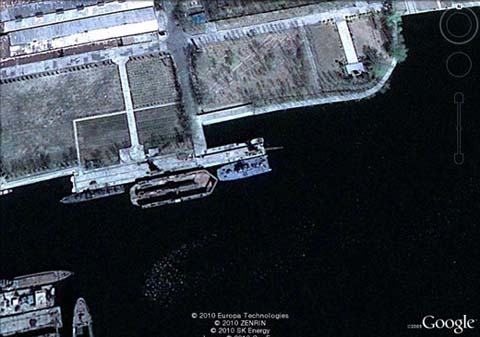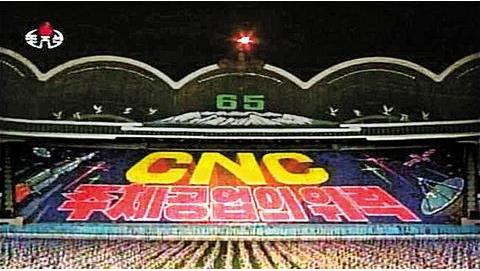North Korea’s red, white, and blue flag flutters on the campus, signs are written in Hangul, and female students stroll through the corridors wearing the traditional jeogori costume. Professors lecture beneath iconic portraits of the father-and-son hereditary dictatorship that has run the reclusive Stalinist state since 1948.
Roughly 800 miles from P’yongyang in Tokyo’s leafy western suburbs, Korea University is an anomaly, an intellectual oasis in a society that distrusts and even despises the ethnic group it caters to—native Koreans loyal to P’yongyang. The institution has never received financial support or even official recognition from the government of Japan.
The university is part of a network of educational institutions established decades ago to serve the Korean population here. Its students wrestle with politics and computer science but also the philosophy of the North’s leader, Kim Jong-il, and the merits of their isolated country’s fossilized centralized government. Surrounded by one of the planet’s most high-tech cities, undergraduates spend their entire four years in Spartan on-campus dorms designed to encourage shared collective identity.
“Part of what we do here is protect our culture,” said the institution’s president, Chang Byong-tai. “Our country and our identity were stolen from us by Japan.”
While unusual, the university for the most part resembles other higher-education institutions, with some notable exceptions. A tour reveals a quiet campus, with aspiring teachers taking a music lesson and students reading in the library, where yellowed English-language newspapers from P’yongyang sat on shelves.
The university offers a standard range of courses, including languages, history, economics, and hard sciences, and has carved out a niche offering legal and other specialist qualifications to Koreans. It has become an academic pit stop for Korean students on their way to Japanese graduate universities.
Set up in 1956, the university is struggling to survive. Hit hard by the decline in Japan’s Korean population, enrollment has plummeted to just 800 students, down from 1,500 in the mid-1990s. Student fees pay for 70 percent of the institution’s costs; donations and endowment investment earnings pay for the rest. Cash from P’yongyang, once a lifeline, has dried up to a thin, unreliable trickle.
“We’re very worried about the future,” said Mr. Chang.
A Political Punching Bag
Mostly left alone for decades by Japan’s authorities, the institution—like any with connections to North Korea here—has recently become a political punching bag. Ultrarightists have driven up this quiet cul-de-sac and blasted the campus with anti-P’yongyang slogans from loudspeakers. Political conservatives have zeroed in on the roughly 70 P’yongyang-affiliated Korean schools that feed the university, demanding they be excluded from a new tuition-waiver system.
“The atmosphere now is very, very bad,” said Kim Yang-Sun, an administrator at the university. Like most of the staff here, Mr. Kim resents the recent attention, which comes on the back of growing tensions between Tokyo and P’yongyang and what he sees as unfair long-term treatment by the Japanese authorities. “Donations to universities are tax deductible in other parts of the world, but not for us. We have been discriminated against.”
Mr. Kim’s ancestors have been in Japan since its annexation of the Korean peninsula in 1910. When occupation ended in 1945, about 700,000 Koreans stayed on rather than return to their homeland, which was then sliding into a war that would eventually split the country into two bitterly opposed states.
These refugees were rendered stateless when Japan’s postwar government ended the citizenship of former colonial subjects in 1947. Well-documented discrimination meant that many found the typical postwar route to prosperity in Japan—lifetime employment in large companies—effectively barred.
When Tokyo normalized relations with South Korea in 1965, Koreans in Japan had to choose essentially an administrative category—to opt for life as a South Korean with permanent residency or to leave the word “Korean” on their alien-registration cards and so become de facto North Koreans. Most declined South Korean citizenship—ironic given that the vast majority originates from the geographic south. South Korea was then a poor dictatorship backed by the United States, while North Korea, though offering little freedom, at least boasted the rhetoric of a “workers’ state.”
“Koreans in Japan were very poor and had no civil rights, so it was a big deal that there was a nation that regarded them as fellow compatriots, that gave them help, and funded this university,” said Sonia Ryang, a professor of anthropology and director of the Center for Asian and Pacific Studies at the University of Iowa.
Today at the university, the grandchildren of those first-generation Koreans struggle with profound identity issues. Many distrust the Kim Jong-il regime but remain loyal out of respect for their parents or the desire to preserve their cultural heritage.
“The reputation of the university is less important that what we study here,” said Ho Tae-jung, a political-economy student. “I’m a Korean, and I want to protect my culture, language, and identity. That’s why my parents and I chose this place.”
Said Ms. Ryang: “They do an amazing job of maintaining Korean culture in a hostile environment.”
Those familiar with the university say one of its unofficial roles is to act as an ethnic matchmaking service. “Most of us want to marry a Korean and have Korean children,” said Yun Minna, a third-year law and politics student at the college.
“I don’t hate Japan, but when you see how our community is getting smaller, it would be better to marry a Korean,” said Mr. Ho.
‘Education Gives Us Pride’
But many Japanese view the community and the college with mistrust since the 2002 revelation that the North Korean military had been kidnapping Japanese citizens in the 1970s and 80s in a bizarre plot to train spies. News-media interest, often prurient, has grown as relations have deteriorated with P’yongyang, which recently became a nuclear power. For conservatives, the university and the rest of North Korean network in Japan are a sort of Trojan horse, breeding disloyalty and even incubating spies. Students and graduates respond that they are the victims of McCarthy-style persecution.
“I don’t talk anymore to the Japanese media because I’m sick and tired of how they portray us,” said Chung Hyon Suk, a graduate of the university who now supervises press events at the Foreign Correspondents’ Club of Japan. Like most students who have graduated from the university, she says there are huge misconceptions about what goes on there. “Students discuss Marx and Lenin, of course, but they can talk very freely and criticize the [P’yongyang] government. A lot of us feel inferior, so education helped give us pride as Koreans, in our language and culture.”
Said Ms. Ryang, who is also a graduate of the university: “Depending on the occasion, students felt free to make jokes about North Korea, but by the same token, again depending on the occasion, students were able to conform with university orthodoxy, upholding North Korea as their glorious fatherland.”
With over 10,000 Koreans a year either assuming Japanese citizenship or swapping their affiliation to South Korea, according to Japan’s Ministry of Internal Affairs and Communications, the minority community served by the university is shrinking, from a peak of 700,000 to just over 400,000. Many parents are sending their children to Japanese schools. For some, that’s an opportunity to bury the past completely and scrap their Korean names and identities.
“We have heard cases of schoolchildren finding photographs of their grandparents wearing Korean dress and being astonished at this background,” said Moogwi Kim, of the Korean Youth Association in Japan. “Their parents kept it from them.”
Mr. Chang, the university’s president, believes that government recognition as a foreign university, which is currently afforded very few Japanese universities, and allowing donations to be tax deductible might help his institution survive.
Ms. Ryang, however, wonders if the university would really welcome recognition by the government. “If it were recognized, it would have to receive periodic inspections, comply with certain levels of transparency, and it has no experience of that.”
She said few people understand how isolated the community and the university felt. “Japan is not a violently segregated community; it’s politely segregated. Until 1981 we were not able to travel outside Japan. I never had Japanese friends when I was a kid. That’s changing now, and the university is within reach of globalization, but is it ready for that?”



